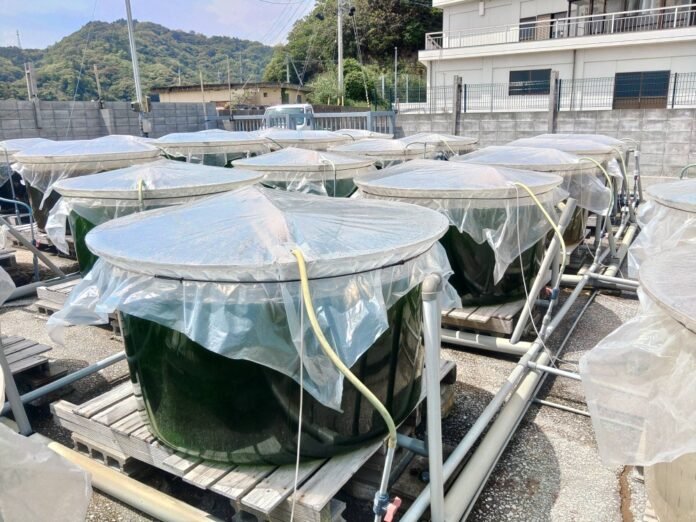The Ariake Sea in the Kyushu region is Japan’s main seaweed-producing area, but persistent poor harvests have prompted researchers to experiment with growing the seaweed on land.
A research team from Kyushu University has discovered that stable seaweed production can be achieved if it is grown in large aquariums where water temperature, light intensity and nutrient supply are maintained in optimal conditions.
However, increasing production yields for commercialization remains a challenge, with the team working to overcome difficulties in collaborating with private companies.
In the mountains of Itoshima, Fukuoka Prefecture, a small door sign with the name “Itoshima lab” hangs on the wall of a wooden warehouse. Inside, clear plastic bottles and containers with seaweed in them can be seen, illuminated by orange and green artificial light. The laboratory is at the forefront of research into land-based seaweed cultivation.
Demonstration trials of land-based seaweed cultivation first began in a research facility in Kitakyushu City, Fukuoka Prefecture.
A group led by Bidyut Baran Saha, professor and principal investigator at Kyushu University’s International Institute for Carbon-Neutral Energy Research, began large-scale research in late 2019.
At the facility they set up an aquarium with about a ton of seawater and placed small pieces of seaweed in it.
The researchers placed artificial light above the seaweed and monitored the amount of carbon dioxide and nutrients. Three days later, the seaweed pieces had grown to a size of 4 to 5 centimeters.
After several rounds of trial and error, the 2023 phase of the experiment was moved to Uwajima, Ehime Prefecture.
The project was entrusted to Three Lines, a Uwajima-based company engaged in cultivation on the land of Ulva prolifera grass kelp and sale of seaweed products such as dried seaweed powder okonomiyaki (a savory pancake). It was the first time that the company started growing Porphyra yezoensisan important seaweed variety at sea.
The company has about 40 aquariums, each holding a ton of water, set up on land overlooking the sea in Uwajima, and growing P. yezoensis in five of them.
Seawater filtered through sandy soil is put into the tanks and the water temperature is kept between 15 and 19 degrees Celsius.
By mixing nutrients, including nitrogen, into the water, the company managed to harvest a total of more than 6 kilos of dried seaweed from one aquarium in a month.
“We believe that the maximum yield has been achieved with this cultivation method,” says Saha.
But to commercialize production, those involved must secure returns that are worth the costs. They aim to harvest 30 kg per month, five times the current amount.
Then the Itoshima laboratory arrived to investigate how to overcome the “6 kg” ceiling.
The laboratory was launched in November 2022 by Daishin, a company in Ibusuki, Kagoshima Prefecture, that breeds and sells eels. The company made an investment and saw potential in Kyushu University’s research.
The laboratory conducted experiments on where to place artificial light to stimulate photosynthesis, and also developed a proprietary culture medium for use in seaweed aquaculture.
It tested more than 100 growing medium materials, including hot spring water, soil and soy pulp.

Hirofumi Ikeya, head of the Itoshima laboratory, transports dried seaweed harvested in mid-April at an onshore cultivation facility in Ehime Prefecture. | Nishinippon Shimbun
“We hope to overcome the yield ceiling by developing the best artificial breeding equipment and systems,” said Hirofumi Ikeya, head of the laboratory.
Traditional seaweed cultivation faces many challenges.
The farming method requires spores to be sown on floating nets, and seaweed that grows into leaf-like structures is picked during the harvest season, which runs from fall to winter.
Poor harvests were recorded in the Ariake Sea last season and growth continues to stagnate this season, affected by weather and seawater conditions.
Land-based aquaculture, meanwhile, has the virtue of allowing cultivation between October and June the following year, producing stable yields and making harvesting less stressful, researchers say.
“Food companies and others are showing great interest in land-based cultivation,” says Saha. “Research into growing nutrient-rich seaweed is becoming more competitive globally.”
The Kyushu University research team is drawing a roadmap for using the research results at the Itoshima laboratory and will continue demonstration trials at Ehime for three years before setting up a large-scale factory with several aquariums to commercialize production.
This section contains topics and issues from the Kyushu region covered by the Nishinippon Shimbun, the largest daily newspaper in Kyushu. The original article was published on May 7.



